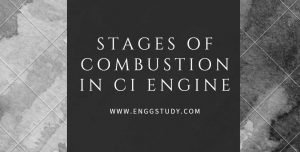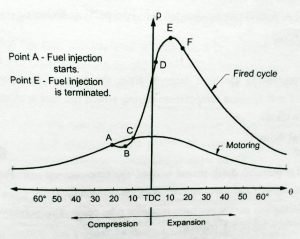
Combustion is a process of the rapid chemical reaction between fuel and the air. This process results in the generation of heat and light. In IC Engine, there are different stages of combustion for different engines. In this post, we are going to focus on stages of combustion in CI engine. Stages of combustion in SI engine are completely different than the CI engines.
In CI or compression ignition engine, in the compression stroke, only air is compressed at very high pressure and temperature. The compression ratio used is in the range of 12 to 120.
The temperature of the air becomes higher than the temperature of the fuel which is diesel in the CI engine. Then diesel fuel is injected in the combustion chamber under very high pressure about 120 to 210 bar. The temperature of this fuel is around 20° to 35° before TDC (Top Dead Center).

Point A on the above graph shows the time at which diesel fuel injection starts. Then, the process of combustion in the CI engine starts. This combustion takes place in four stages as discussed below.
Table of Contents
Stages of Combustion in CI engine:
There are four different stages of combustion in CI engine where proper combustion of air and fuel takes place as follows:
- Ignition Delay Period
- Period of Uncontrolled Combustion
- Period of Controlled Combustion
- After Burning
1. Ignition Delay Period
At this first stage of combustion in the CI engine, the fuel from the injection system sprayed in the combustion chamber in the form of a jet. Due to atomization and vaporization, this fuel disintegrates at the core which is surrounded by a spray of air and fuel particles.
In this vaporization process, the fuel gets heat from the compressed and hot surrounding air. It causes some pressure drop in the cylinder. You can see this pressure drop (curve AB) in the above figure.
After completion of the vaporization process, the preflame reaction of the mixture in the combustion chamber starts. During the preflame reaction, pressure into the cylinder starts increasing with the release of energy at a slow rate.
This preflame reaction starts slowly and then speeds up until the ignition of the fuel takes place. You can see this process at point C on the diagram.
This time interval between the starting of the fuel injection and the beginning of the combustion is called the delay period. This delay period can further be divided into two parts – Physical delay and chemical delay.
The period between the time of injection of the fuel and its achievement of self-ignition temperature during vaporization is called physical delay. When physical delay completes, the time interval up to the fuel ignites and the flame of the combustion appears is called chemical delay.
Preflame reaction we discussed above is taking place during the chemical delay. Due to the complex process of combustion is a CI engine, it’s difficult to separate these two delay periods.
If this delay period performs longer than usual, then we can here knocking in CI engine.
2. Period of Uncontrolled Combustion
This is the second stage of combustion in the CI engine. After the above-mentioned delay period is over, the air and fuel mixture will auto-ignite as they have achieved their self-ignition temperature.
The mixture of air and fuel in CI engines is heterogeneous unlike homogeneous in the SI engines. Due to this heterogeneous mixture, flames appear at more than one location where the concentration of the mixture is high.
When the flame formed the mixture in the other low concentration starts burning by the propagation of flames or due to auto-ignition, because of the process of heat transfer.
The accumulated fuel during the delay is now started burning at an extremely rapid rate. It causes a rise in in-cylinder pressure and temperature. So, the higher the delay period, the higher would be the rate of pressure rise.
During this stage, you can’t control the amount of fuel burning, that’s why this period is called a period of uncontrolled combustion. This period is represented by the curve CD in the above figure.
3. Period of Controlled Combustion
When the accumulated fuel during the delay period completely burned in the period uncontrolled combustion, the temperature and pressure of the mixture in the cylinder are so high that new injected fuel from the nozzle will burn rapidly due to the presence of sufficient oxygen in the combustion chamber.
That’s the reason we can control the rise of pressure into the cylinder by controlling the fuel injection rate. Therefore, this period of combustion is called a period of controlled combustion.
4. After Burning
This is the last stage out of the four stages of combustion in CI engine.
Naturally, the combustion process is completed at the point when the maximum pressure is obtained in the combustion chamber at point E as shown in the figure.
Practically, the burning of the fuel in the combustion chamber remains to continue during the expansion stroke. The main reason behind it is the reassociation of dissociated gases and unburnt fuel.
Therefore, this last phase of combustion is called After Burning.
These are the four different stages of combustion in CI engine.
Final Words
We have discussed four stages of combustion chamber in CI engine such as ignition delay period, period of uncontrolled combustion, period of controlled combustion and after burning. If you have any queries about this article on combustion in CI engine, then feel free to put it in the comment box. See you!
Hello
Hey author,
could you please remove my all comments which are pointed at my domain?
Thanks so much for sharing this awesome info! I am looking forward to see more postsby you!